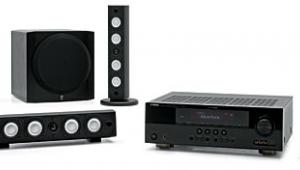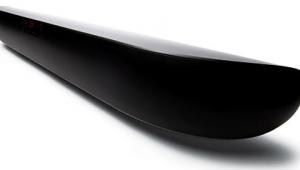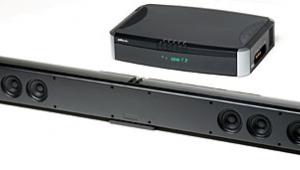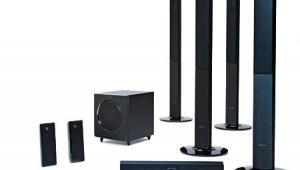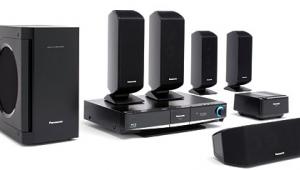Polk SurroundBar 360˚ DVD Theater Page 2
So much for location. What about sound quality? The male voice sounded focused and pinpoint-precise with the front left, center, and right signals. With the surround-left and surround-right signals, it was a little more diffuse, but it was still suspended fairly precisely between front and rear on each side.

The pink noise’s character varied from channel to channel. The front center-channel pink noise tilted slightly toward the higher frequencies than that in the front left and right channels. And the surround-channel pink noise was tilted slightly toward lower frequencies than the front channels. I didn’t attempt to measure anything with an SPL meter, although I did notice varying levels in the magic channels depending on the input.
Of course, Polk didn’t design the 360 to produce specific effects for nerds with tones. It’s an entertainment machine, and movies and music are more dynamic than test tones. So I moved on to normal listening.
Shouting, Singing, Screaming
All movie auditions were DVDs with Dolby Digital 5.1 soundtracks. With age, Al Pacino’s voice has gotten hoarser. Yet it somehow sounded musical as he flings himself through the intricate serial-killer plot of 88 Minutes. The phantom center remained commendably solid with small head movements. When I made bigger moves—from the sofa’s on-axis side to its off-axis side—the vocal shift was pretty minor, and the front soundstage did not collapse. The 360’s magic doesn’t depend on wall reflections, so the soundfield was fairly impregnable.
La Vie en Rose is a biopic about Edith Piaf, France’s small, fiery, and indomitable songbird. Here, her warm, quivering, caramel voice is discernibly anchored in performance spaces that range from streets to cabarets to larger nightclubs to concert halls. Not for the first or last time, I felt like I experienced something that was not quite stereo and not quite surround. It was certainly bigger than generic two-channel. The surround-like effect wasn’t enveloping, but it was involving. In this richly emotional movie, it kept me anchored to the story.
 Werner Herzog’s Rescue Dawn is the true story of a downed American pilot’s survival in the communist prison camps and jungles of Laos in 1965. Although the film includes generic war noises—including some impressively directional scattering debris during a plane crash—the dominant surround effects are immersive jungle ambiences. It’s not the same jungle every time; it changes its character as the hero moves around. How far the ambience reached from front to back depended on the material. Sometimes it seemed startlingly real. About halfway through the film, I also noticed that the soundtrack is dominated by a solo cello that changes its mood several times before it finally merges back into the orchestra that plays over the final credits. The instrument’s mood shifts and woody warmth gave the 360 a chance to show off its musicality. It also provided a human foil to the dehumanizing brutality that prisoners of war suffer.
Werner Herzog’s Rescue Dawn is the true story of a downed American pilot’s survival in the communist prison camps and jungles of Laos in 1965. Although the film includes generic war noises—including some impressively directional scattering debris during a plane crash—the dominant surround effects are immersive jungle ambiences. It’s not the same jungle every time; it changes its character as the hero moves around. How far the ambience reached from front to back depended on the material. Sometimes it seemed startlingly real. About halfway through the film, I also noticed that the soundtrack is dominated by a solo cello that changes its mood several times before it finally merges back into the orchestra that plays over the final credits. The instrument’s mood shifts and woody warmth gave the 360 a chance to show off its musicality. It also provided a human foil to the dehumanizing brutality that prisoners of war suffer.
A problem emerged with the DVD drive’s pause function. When I paused a movie and went away for 10 or 15 minutes, the program would resume at the next chapter stop following the pause point. Polk attributed the tic to a control-software bug. A firmware upgrade (via the console’s USB jack) will eventually fix the problem. The company sent a different sample to our studio, and the problem didn’t occur again.
Crow, Duke, Lenny
Although the 360 worked its magic both on and off axis, it was most effective on axis. With music, I always make more of an effort to stay in or near the sweet spot. At first, to get a solid on-axis blast, I sat on the floor in front of the sofa, which gave the soundstage a chance to spread (with optimum program material) from slightly in front of the 360’s left side around to the corresponding spot on the right. Discomfort eventually drove me to elevate the speaker for sofa listening. I placed it directly in front of the then-unused LCD TV. If you use the 360 with a TV, you’ll need to make one of three adjustments: position the screen slightly higher or lower than would be ideal, listen to the bar slightly off axis, or install the bar so that it points slightly upward or downward. It might be wise to experiment before you commit to a permanent wall mount.
Sheryl Crow’s untitled second album gave the 360 a certified classic to work with—and the phantom center did justice to her rising wail on “If It Makes You Happy.” I was also struck by the tremolo guitar on “Redemption Day,” which turned into a magic-processing feast, floating tantalizingly in the center of the room. When the magic worked, it really worked. Considering the fact that the system produces bass through 2.5-inch drivers, the rhythm section sounded solid, although not as tight as better-than-average conventional speakers. The 360 includes a sub out if you want more bass.
The slightly murky Crow mixes tended to define a soundstage about a foot outside each end of the bar. On the other hand, Duke Ellington’s New Orleans Suite was recorded clean and flat with very little reverb. As a result, the soundstage was narrower and tightly bound to the edges of the bar. That gave the richly varied big-band arrangements a strong density.
Concert halls and similarly large reverb-rich spaces showed the 360 to best advantage. The strongest audition was The Original Jacket Collection: Leonard Bernstein, a 10-disc compendium of Leonard Bernstein conducting his symphonies, suites, ballets, and other works. Disc one includes material from Candide, West Side Story, On the Waterfront, and Fancy Free. The New York Philharmonic spread out in a spacious manner. Strings were strongly outlined, as on a lot of Bernstein’s Philharmonic recordings. Some instruments, like triangle, leaped out of the mix with stunning spatial precision. Others became part of the background texture that oozed out of the bar in all directions.
It’s safe to say that Polk Audio’s SurroundBar 360 DVD Theater is the most original and effective approach to one-speaker bar systems I’ve experienced. It boldly goes where no bar speaker has gone before.

- Log in or register to post comments








